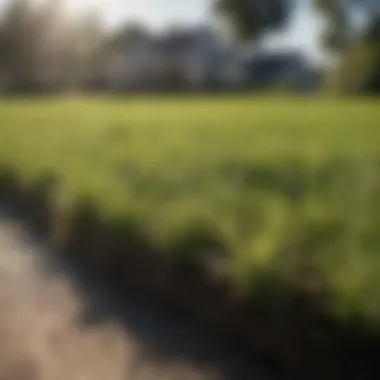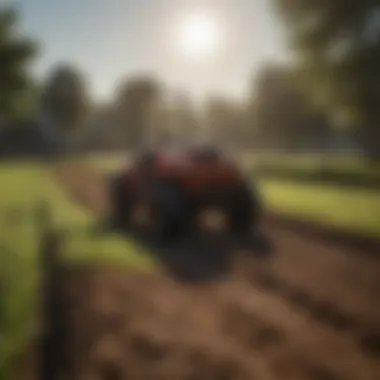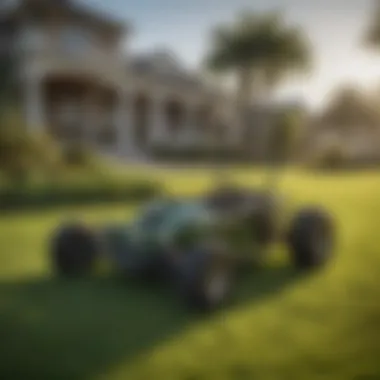Understanding Sod Installation in Gainesville, FL


Intro
Sod installation is a significant practice in Gainesville, Florida, where the warm climate and specific soil conditions can greatly affect the choice of sod types and installation methods. This article aims to explore the various effects and considerations surrounding sod installation in this unique region. Understanding these factors is crucial for both professionals and home enthusiasts who are looking to implement successful landscaping projects.
In particular, this article will look into the types of sod that thrive in Gainesville, installation techniques that ensure longevity, maintenance best practices to keep grass healthy, and cost factors that may influence decisions. Furthermore, the environmental impact of these practices is also essential to consider, especially within the context of Florida's delicate ecosystem.
By diving into the details of sod installation, readers will gain valuable insights that can help them make informed choices, leading to a more sustainable and beautiful lawn.
Intro to Sod in Gainesville
Sod installation in Gainesville plays a pivotal role in the landscaping and agricultural practices of the region. The significance of sod lies not only in its aesthetic enhancement but also in its practicality. When properly installed, sod offers various benefits, including improved soil quality, stabilization of the ground, and an immediate green cover that promotes a welcoming environment. In a community where outdoor spaces are valued, sod becomes an integral element to achieve a lush and sustained landscape.
Overview of Sod Usage
In Gainesville, sod is more than a decorative element. It serves functional purposes that support both residential and commercial landscaping. Sod is often used in lawns, parks, and sports fields to create a visually appealing and functional space. The immediate effect of layng sod is visible. Homeowners can transform bare ground into a verdant oasis within a short time, which is especially important for new constructions or renovations.
Additionally, sod can minimize soil erosion and help retain moisture in the ground. The roots of the grass create a network that keeps soil intact. This aspect is particularly pertinent to the sandy soils often found in Florida. Moreover, sod can improve air quality and contribute to urban heat mitigation by providing cooling effects in neighborhoods.
Importance of Local Context
Understanding the local context is critical when considering sod installation. Gainesville's unique blend of subtropical climate and diverse soil types necessitates careful selection of the right sod type and installation techniques. It’s not merely about laying down grass. Local climate conditions influence growth rates and maintenance requirements. For instance, while Bermudagrass thrives in sunny areas, St. Augustine may be more suitable for shaded environments.
Additionally, the local ecosystem cannot be overlooked. Using sod varieties that are native or adapted to Florida's environment supports biodiversity. This improves overall resilience and health of the sodded area, lessening the need for harsh chemicals or excessive watering. When contemplating sod installation in Gainesville, aligning with local environmental considerations ensures better long-term outcomes.
Climate Considerations
Understanding climate considerations is essential when discussing sod installation in Gainesville. The region's unique combination of temperature, humidity, and rainfall patterns significantly influences sod selection and care practices. This knowledge helps homeowners and professionals make informed choices that promote healthy grass growth and sustainability.
Temperature and Humidity Profiles
Gainesville experiences a subtropical climate, characterized by hot summers and mild winters. The temperature averages range from the mid-70s in winter to high 90s during the summer months. High humidity levels can exceed 80% during the peak summer days, impacting turf health.
When selecting sod, it is crucial to consider these temperature and humidity profiles. For instance, intense heat demands grass types that can withstand heat stress, such as Bermudagrass. This variety thrives in warm conditions and offers resilience against drought.
Additionally, the humidity levels contribute to certain grass diseases, such as brown patch. Gardeners should account for these environmental factors during installation and care phases to enhance the longevity of the sod.
Rainfall Patterns and Their Effects
Gainesville receives a significant amount of rainfall, averaging around 50 inches per year, mostly concentrated in the summer months. However, rainfall can be unpredictable, with periods of heavy downpours followed by drought.
These variabilities determine the effectiveness of sod irrigation and overall soil moisture. For instance, new sod requires consistent watering initially to establish roots. After that, the natural rainfall can contribute to maintaining soil moisture levels for the grass.
Furthermore, it is important to note how excessive rainfall can lead to issues like soil erosion and turf diseases. Proper drainage systems can help mitigate these factors, ensuring protective measures for sod health in both wet and dry seasons.
In summary, addressing climate considerations is fundamental in ensuring sod installation's success in Gainesville. Understanding the temperature, humidity, and rainfall patterns aids in selecting suitable grass types and applying effective maintenance practices for long-term viability.
Types of Sod for Gainesville
The selection of sod types is fundamental for successful installation in Gainesville. Choosing the right type can influence not only the aesthetic appeal of a landscape but also its resilience against pests and pathogens. Local environmental conditions, such as soil type and weather patterns, greatly affect the sod's performance. Understanding these variations helps in making informed decisions that lead to durable and healthy lawns.
Bermudagrass: Characteristics and Benefits
Bermudagrass is one of the most popular choices for Gainesville due to its heat tolerance and rapid growth rate. This grass type establishes quickly, which is ideal for homeowners who want instant results. Bermudagrass can withstand heavy foot traffic, making it suitable for residential lawns, sports fields, and golf courses.
In terms of maintenance, Bermudagrass requires regular mowing, ideally kept at a height of about one to two inches. This encourages healthy growth and reduces thatch buildup. It benefits from a well-planned fertilization schedule to sustain its green appearance.
"Bermudagrass offers resilience and aesthetic beauty, ideal for Florida's warm climate."
Zoysiagrass: Adaptability and Maintenance


Zoysiagrass is another viable option for homeowners in Gainesville. Known for its adaptability, Zoysiagrass thrives in various soil types and has a moderate growth rate compared to Bermudagrass. Its dense growth creates a plush lawn that can resist weeds effectively.
One corner stone of Zoysiagrass maintenance is its mowing height, which should stay around 1 to 2 inches. It is essential to maintain a balance; too low may expose the roots, while too high can lead to a thatch issue. Zoysiagrass also requires less frequent watering once established, making it a more sustainable option for those conscious of water usage.
St. Augustine Grass: Suitability for Residential Areas
St. Augustine grass is particularly favored in coastal areas of Florida, including Gainesville. Its broad, dark green blades can bound a yard beautifully. This grass is more shade tolerant than its counterparts, making it suitable for yards with partial sunlight.
Maintenance for St. Augustine grass includes regular edging and mowing, with a recommended height of three to four inches. Fertilization should occur during the growing season. This type of grass is susceptible to certain pests and diseases, necessitating a proactive pest management strategy to maintain health.
Sod Installation Techniques
Sod installation techniques play a critical role in determining the success of establishing a healthy and vibrant lawn in Gainesville. Choosing the right method influences the sod’s growth, durability, and overall appearance. Each step in installation impacts both immediate results and long-term maintenance needs. Proper techniques ensure the sod can thrive in Gainesville’s specific climate and soil conditions, ultimately benefiting property owners and environmental health.
Preparing the Site
Soil Testing
Soil testing is an essential step in preparing the site for sod installation. It evaluates the nutrient levels and pH balance of the soil. A well-balanced soil provides a conducive environment for sod rooting. Knowing the nutrient deficiencies allows property owners to adjust their soil composition through amendments. This reduces the risk of future problems with grass health, making soil testing a wise investment.
The main advantage of soil testing is overall soil health. It is not only beneficial but might be necessary where the soil has shown signs of poor growth. For instance, sandy soils common in Gainesville may require specific nutrient additions. Testing can also reveal contaminants or issues that could hinder sod establishment.
Site Clearing
Site clearing involves removing old grass, debris, and any obstructions from the installation area prior to laying the sod. This step is crucial because it not only prepares a clean slate for new sod but also minimizes competition from weeds. A cleared site allows for better contact between the sod and the soil, essential for rooting.
One key characteristic of site clearing is that it sets the foundation for successful sod installation. Property owners who properly clear their site often see quicker and healthier sod establishment. However, the process may require considerable effort and resources, especially in densely vegetated areas. Proper tools and perhaps professional help might be necessary to achieve optimal results.
Laying the Sod
Alignment Techniques
Alignment techniques are vital when laying sod rolls or squares. Proper alignment ensures that the pieces fit together tightly, reducing gaps that could create unappealing seams. This creates a uniform appearance once established. Accurate alignment also encourages even growth, as water and nutrients will distribute more efficiently.
The critical aspect of alignment techniques lies in the precise placement of each piece. Without careful attention, misaligned sod can lead to uneven growth patterns and visible seams. Many professionals emphasize the importance of checking alignment frequently during installation to prevent mistakes.
Seaming Sod Properly
Seaming sod properly is imperative for a successful installation. It involves butting the edges of sod pieces securely against each other to eliminate gaps while integrating the sod sections. The unique feature of proper seaming is its impact on water retention and nutrient uptake. When seams are well-placed, grass can more effectively access water and nutrients from the soil below.
An important element of this process is watching the direction of the seams. Misaligned seams can cause visible lines on the lawn surface. Furthermore, gaps may lead to weed infiltration. Therefore, spending time to seam sod properly at this stage will pay off in long-term maintenance and appearance.
Post-Installation Care
Watering Schedule
Establishing a watering schedule after the sod is laid is crucial for promoting strong root growth. The initial watering helps the sod pieces to knit together and begin the rooting process. A consistent schedule ensures the sod does not dry out while developing roots.
The key characteristic of a watering schedule lies in timing. Newly installed sod typically requires daily watering until it roots into the soil. This close attention helps reduce the stress on young grass, giving it the best chance to thrive. Failure to water appropriately could result in patches of dead grass. However, too much water can also pose risks, leading to root rot or fungal diseases.
Fertilization Timing
Fertilization timing is another essential aspect of post-installation care. Proper timing of the first application of fertilizer supports new grass as it establishes itself. Generally, application should occur a few weeks after installation, allowing the roots to take hold.
The distinctive feature of fertilizer timing is that it can significantly enhance the initial growth phase of the sod. Properly timed fertilization will boost the nutrition available to the sod without causing nutrient overload. Skipping this step or applying at the wrong time could stunt growth or lead to poor color and vigor in the grass.
Implementing effective sod installation techniques leads to greener and healthier lawns, particularly in regions like Gainesville.
By carefully preparing the site, laying the sod with proper alignment and seams, and maintaining a diligent care regimen post-installation, property owners can ensure their sod installation is successful.


Maintenance Considerations
Maintaining a sod installation is crucial for ensuring the health and longevity of the turf in Gainesville's unique ecological setting. The humid subtropical climate presents both opportunities and challenges for sod health. Regular care can lead to a lush, resilient lawn, while neglect may result in a variety of problems. Proper maintenance encompasses several key components, including mowing practices, weed control strategies, and pest management. This section will detail these areas, shedding light on their significance.
Mowing Practices
Mowing is not just a routine task; it directly influences the health of sod. The height at which sod is cut can affect its growth, root development, and overall vigor. In Gainesville, it is recommended to maintain Bermudagrass at a height of about one to two inches. For Zoysiagrass, a slightly higher cut of about two to three inches is advisable, while St. Augustine Grass should be cut at a height of three to four inches.
- Benefits of Proper Mowing:
- Promotes healthy growth.
- Reduces weed establishment.
- Improves drought resistance.
Mowing frequency is important as well. During the growing season, lawns should be mowed at least once a week. Avoid cutting more than one-third of the leaf blade at a time, as this can shock the plant and lead to stress. Keeping blades sharp is also essential to ensure clean cuts, which reduces the risk of disease.
Weed Control Strategies
Weeds can quickly overtake a lawn, competing with sod for necessary nutrients, light, and moisture. Effective weed control strategies are essential for maintaining a healthy sod installation.
- Cultural Practices:
- Chemical Control:
- Regular mowing prevents weeds from flowering and setting seed.
- Fertilization schedules tailored to specific sod varieties improve overall sod strength, making it less susceptible to weeds.
- Pre-emergent herbicides can minimize the growth of annual weeds when applied before they germinate.
- Post-emergent herbicides can be used for actively growing weeds, with a careful selection based on the weed type to avoid damaging the sod.
Constant vigilance is required. Manual weeding or spot treatments should be part of regular maintenance to ensure a healthy lawn free of invasive species.
Pest Management
Pest management in sod is an often-overlooked aspect that can have significant implications on sod health. In Gainesville, common pests include grubs, armyworms, and chinch bugs. Each pest has its own management strategy.
- Monitoring for Pests:
- Integrated Pest Management (IPM):
- Regular inspections of the lawn can help catch infestations early. Look for signs such as discoloration, wilting grass, or the presence of insects.
- This approach combines biological, cultural, mechanical, and chemical tools to manage pests. For example, maintaining healthy sod can make it less attractive to pests.
"A proactive approach in pest management leads to a healthier sod and reduces long-term treatment costs."
Implementing these pest management strategies will contribute to the overall resilience and beauty of the sod.
In summary, consistent and informed maintenance is crucial for the success of sod installations in Gainesville. This ensures not just the temporary aesthetic appeal but also contributes to the long-term viability of the lawn.
Cost Analysis of Sod Options
Understanding the cost implications of sod installation is crucial for both professionalism and personal projects. Evaluating the financial aspects can help landowners make informed choices about sod types and installation methods. The expenses can vary considerably based on the selection of sod, installation labor, and ongoing maintenance. This section will dive into both initial installation costs and long-term maintenance costs, providing an in-depth perspective on the overall investment required for successful sod management.
Initial Installation Costs
When considering sod installation in Gainesville, the initial costs involve several factors that contribute to the final price. These include the sod type, delivery charges, site preparation, and labor.
- Sod Type: Different sod varieties like Bermudagrass, Zoysiagrass, and St. Augustine grass come with unique price points. For instance, St. Augustine grass typically costs more due to its popularity and specific growing needs.
- Site Preparation: Before laying sod, soil testing and amendments may be necessary. This step ensures a good foundation for growth, but adds to the upfront cost. Proper site clearing and leveling also require additional investment.
- Labor Costs: Hiring professionals can elevate costs, yet their expertise often results in a better outcome. Homeowners may opt for DIY installation to save money, but need to assess if their skills can achieve a satisfactory result.
In essence, budgeting for initial installation requires careful planning and a clear understanding of what is needed for success. It is recommended to obtain multiple quotes from local sod suppliers and installers, facilitating comparisons to find the best value.
Long-Term Maintenance Costs
Long-term maintenance is a significant part of the investment in sod. Ongoing costs will vary based on several variables including sod variety, climate conditions, and specific care routines adoptedd. Understanding these factors can save time and money in the long run.
- Watering: Regular irrigation is essential, especially in Gainesville's warm climate. Adjusting watering schedules can lead to substantial costs in utility bills, making it essential to develop a strategic watering plan.
- Fertilization: Different sod types have varying nutrient needs. Investing in suitable fertilizers at the right intervals ensures the sod remains green and healthy, but these costs can add up over time.
- Pest and Weed Management: Money spent on herbicides and pesticides can fluctuate based on the presence of pests and weeds. Integrated pest management practices can help control these expenses, driving sustainability while ensuring lawn health.


Long-term costs require attention to detail and proactive management to achieve the desired aesthetic while minimizing financial impact.
Planning for these long-term maintenance costs early can aid in preventing unexpected expenditures. Keeping a maintenance schedule may also contribute to a healthier lawn. Understanding the cost landscape of sod installation enables informed decision-making, ultimately leading to better outcomes for both plants and homeowners.
Environmental Impact of Sod
The discussion surrounding sod installation often includes a significant concern: its environmental impact. This topic is vital as it highlights both the positive and negative effects that sod can have on local ecosystems. Understanding these impacts helps landowners, farmers, and enthusiasts make informed decisions. Effective management of sod can yield benefits like improved soil stability and increased property aesthetics. Conversely, poorly planned sod installations can lead to issues like excessive water usage and reduced biodiversity.
Water Consumption Considerations
Impact on Local Water Resources
One critical aspect of water consumption considerations is how sod affects local water resources. In Gainesville, the region's climate features significant rainfall, yet periods of drought can occur. When sod is installed, it requires a consistent watering regimen to establish roots. This necessity can strain local water resources, particularly during dry spells. The choice of sod type plays a significant role in this equation.
For instance, Zoysiagrass is more drought-tolerant compared to St. Augustine Grass. Therefore, selecting a sod type that requires less water not only benefits the environment by conserving water but can also reduce the cost of maintenance.
Moreover, installing sod can have a dual effect on the water cycle. While it helps retain soil moisture, leading to efficient water usage post-establishment, improper irrigation practices can result in runoff, polluting local waterways.
"Choosing suitable sod is pivotal for responsible water management and environmental sustainability."
Biodiversity and Habitat Effects
The biodiversity and habitat effects of sod installation warrant careful consideration. While sod can provide a green refuge in urban areas, it may limit the variety of native plants and habitats available for local fauna.
In Gainesville, native grasses and plants support a diverse array of insects and wildlife. In contrast, conventional sod varieties often create monocultures. These can be detrimental as they fail to provide the same habitat complexity as undisturbed ecosystems.
To promote biodiversity, it is crucial to incorporate native plant species into landscaping plans. This practice enhances habitat availability for pollinators and other beneficial organisms.
In summary, while sod can enhance the beauty and usability of land, it is essential to consider its environmental impact, particularly regarding water usage and effects on biodiversity. Sustainable practices and conscientious choices are essential in ensuring that the benefits of sod installation outweigh the negatives.
Innovative Practices in Sod Management
Innovative practices in sod management are increasingly crucial for ensuring sustainable growth and health of turf in Gainesville, Florida. These practices address not only the efficiency of resource use but also contribute to the long-term viability of sod. With ongoing changes in climate and environmental regulations, adopting innovative methods can yield numerous benefits that extend beyond mere aesthetics.
Sustainable Sod Cultivation Techniques
Sustainable sod cultivation techniques focus on minimizing environmental impact while optimizing growth conditions. This includes using organic fertilizers that support soil health without contributing to chemical runoff. Practicing no-till farming methods can also improve soil structure and reduce erosion risks.
Water conservation is paramount in regions like Gainesville. Employing smart irrigation systems helps to ensure that sod receives adequate moisture without excessive waste. Rain sensors and drip irrigation systems can output water only when needed, which is especially useful during fluctuating rainfall patterns.
Regular soil testing provides insights into nutrient levels and pH, enabling targeted amendments that enhance sod health. This scientific approach allows for more precise adjustments, reducing both material costs and potential environmental negatives.
Research on New Varieties
Research on new varieties of sod is vital for adapting to the specific conditions in Gainesville. Breeders focus on developing grasses that are drought-resistant or pest-resistant, which can significantly reduce the need for irrigation and chemical treatments. Varieties such as improved Bermudagrass or Zoysiagrass are being tested for their resilience against local pests and diseases.
University-led projects sometimes include public participation, which can foster community interest and awareness. Collaborating with research institutions provides farmers and sod enthusiasts the most up-to-date information on available varieties. This helps ensure that sod remains economically and environmentally sustainable.
Ongoing research and development lead to sod options that require less maintenance, are more durable under foot traffic, and exhibit enhanced growth rates. Those engaging in sod management should remain updated with the latest findings to make informed decisions that align with both ecological and economic goals.
Finale and Future Considerations
Understanding the effects and considerations of sod installation is vital for anyone engaged in landscaping, agriculture, or simply maintaining a healthy lawn in Gainesville, Florida. Sod serves as more than just an aesthetic element; it impacts environmental sustainability, resource management, and local ecology. The conclusion of this article emphasizes the need for careful selection of sod types, installation techniques, and ongoing maintenance practices tailored to the specific conditions of Gainesville.
Summation of Key Points
In summary, several critical points emerged throughout the article:
- Climate Impact: The unique climate of Gainesville necessitates specific sod types that can thrive under its temperature and humidity profiles.
- Types of Sod: Choices such as Bermudagrass, Zoysiagrass, and St. Augustine Grass offer different benefits depending on the intended use and local conditions.
- Installation Techniques: Proper preparation of the site, careful laying of the sod, and post-installation care are essential for successful establishment.
- Maintenance: Ongoing care that includes mowing, weed control, and pest management is crucial for sustaining a healthy lawn.
- Cost Analysis: Both initial and long-term costs should be considered when choosing sod options.
- Environmental Considerations: The ecological impact, particularly regarding water consumption and biodiversity, must remain a priority for sustainable practices.
Future Trends in Sod Management
Looking ahead, several trends are likely to shape sod management in Gainesville:
- Sustainable Practices: Increased awareness of environmental impact will drive the adoption of sustainable sod cultivation techniques. This includes integrated pest management, water-saving irrigation, and organic fertilizers.
- Research Advancements: Ongoing research into new sod varieties will enhance adaptability and resilience to climate variations and disease pressures, fostering healthier growth.
- Technological Integration: The use of technology will likely grow in monitoring sod health and soil conditions, enabling more precise care and resource use.
The future of sod management in Gainesville hinges on sustainable practices and robust research efforts to ensure long-term viability for both lawns and the environment.















